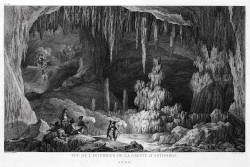Greece - About the Country

Like Greece’s archaeological treasures, its caves were first explored by foreign visitors. At this time, during the nineteenth century, the locals had no idea about exploring or researching, the country was poor and rural. The industrial nations, like England and Germany, soon had several rich families, which became rich as a result of the industrial revolution. Some of their members started to fill their ample free time with cultural and scientific work. A good example is Heinrich Schliemann, who was a merchant and spent his money by searching for the places mentioned in the books of Homer. He discovered Mykene, Tirene, Troja and others.
Probably the first known speleological exploration was done by the German traveller and geologist Fiedler, who visited
 Katafyki Cave
on Kythnos in 1841.
Later cave visits were made by organized walking clubs and mountaineers followed.
Katafyki Cave
on Kythnos in 1841.
Later cave visits were made by organized walking clubs and mountaineers followed.
This changed, when in 1950 the Ελληνικηζ Σπηλαιολογικη Εταιριαζ (Hellenic Speleological Society) was founded by Ioannis Petrocheilos and his wife Anna Petrocheilou. Both were extraordinary speleologists and scientists. Anna Petrocheilou was Greek’s first female mountaineer. She was the first woman to climb several mountains in Greece, the Alps and all over the world. The two dominated the Greek speleology for many decades. The objective of the Hellenic Speleological Society is the systematic exploration and study of caves. Today the Greek cave cadastre contains more than 10,000 caves. Anna Petrocheilou mentions in her book about Greek caves about 100 show caves. But she includes all caves which are accessible to the public, even if they are not developed. A more recent guess would be about 30 tourist caves, with one third being real show caves and two thirds being rather wild caves, often without electric light and without safe path.
Greece is an interesting country, but I had some troubles when travelling there. So I tried to collect some typical sides of the country, not to embarrass the locals, but in the hope it might help other travellers. However, it is just a small explanatory text, as this site is primarily dedicated to caves, not to travelling.
There were three things I had many problems with:
- The signposts are, well, individualistic. Sometimes you find a sign every 100 m telling you exactly how far it is. Then you find a big new sign and have to guess the rest of the way. Or there is a sign pointing up a road suitable for goats only. But you have no idea if you will have to walk for days, or if it is just behind the next tree. I tried to help you by giving a good description how to get there, if I actually found my way...
- It is pretty hard to find an overnight stay if you travel around. Greece seems to be in the hands of big travel agencies, organizing the stay at beach hotels and bus tours to the sights. If you travel alone, you will have problems finding a hotel, finding a campground or whatever. Hotels are typically concentrated on the beach, in the back country there are three tavernas for a village with 10 houses, but only one hotel on 1,000 tavernas. After some time I found out that there are normally some hotels around famous excavation sites, like Olympia or Delphi, so have a look on your map and try to reach one of them every evening.
- The maps are catastrophic.
The general explanation is, only the military has good maps, and they keep them secret.
This might be true.
The Greek military is the last one in the so-called "free world", which is pretty paranoid with tourists taking a picture of any kind of military installation.
Sounds a bit like Cold War times.
And the common signs, prohibiting photography, are a good help for spies if they look for military installations anyway, as 99.9 % of them are absolutely insignificant...
However, after some research, I found at least one detailed map, although it was wrong several times: Euro-Regionalkarte 1:300.000 Griechenland from RV Verlag in Germany. The names are given in both, Latin and Greek letters, which is very helpful.
Text by Jochen Duckeck (2002). With kind permission.
A last word on the written Greek. The Greeks use their own alphabet, which is similar, or better the grandfather of the kyrillic alphabet. A Greek monk used this alphabet when he developed the written Russian. If you ever learned some maths, you may already know the φ, ρ or σ.
Unfortunately, it is arduous to read for foreigners, who feel almost illiterate. Even if you know the characters, you are not able to read fluently. The Greek know about this problem, and most signs are written in both Greek and Latin letters. Good maps also always give both versions.
We tried to do the same on our site. So all cave names are given first in the greek alphabet, then they are written in Latin letters, and finally they are translated. The navigation uses the greek names written in Latin letters. This is unfortunately a bit problematic: there are often several ways to write greek words in Latin letters. The greek letters have different phonetic equivalents, so there may be different ways to "transliterate" them. We tried to use the most common one and only one version on the whole site.
- Additional Information about Greece
 Search DuckDuckGo for "Greece+cave"
Search DuckDuckGo for "Greece+cave" Show Caves of Greece - to spílaio tis Elládas (visited: 20-APR-2021)
Show Caves of Greece - to spílaio tis Elládas (visited: 20-APR-2021)
 Index
Index Topics
Topics Hierarchical
Hierarchical Countries
Countries Maps
Maps